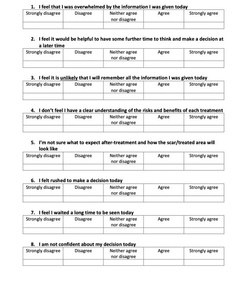Banks, J; Odili, J; Zaidi, S; Lalondrelle, S; Singh, M; Akhras, V; Jiyad, Z
(2022)
The development and validation of a decision aid to facilitate patient choice of surgery versus radiotherapy for high-risk basal cell carcinoma.
Clin Exp Dermatol, 47 (11).
pp. 1995-1997.
ISSN 1365-2230
https://doi.org/10.1111/ced.15325
SGUL Authors: Akhras, Victoria Jiyad, Zainab
|
PDF
Published Version
Available under License Creative Commons Attribution. Download (1MB) | Preview |
|
![[img]](https://openaccess.sgul.ac.uk/114535/11.hassmallThumbnailVersion/ced15325-sup-0001-figures1.jpeg)
|
Image (JPEG) (Supplementary Figure S1)
Published Version
Available under License Creative Commons Attribution. Download (107kB) | Preview |
|
|
PDF
Accepted Version
Available under License Creative Commons Attribution. Download (1MB) | Preview |
Abstract
Basal cell carcinoma (BCC) is an increasingly common cancer. For high-risk BCCs, there are several treatment options, with similar efficacies. The current best practice in deciding upon a particular treatment is for a patient-centred approach. At present, there are few resources available for patients to assist their choice. This reduces patient autonomy and increases the burden on clinicians within clinic. Patient decision aids (PDAs) have been shown to increase patient autonomy and facilitate shared decision-making. Currently, there is no published PDA designed to facilitate the decision between surgical management or radiotherapy in high-risk BCCs. We developed a novel decision aid designed along the International Patient Decision Aid Standards to fill this clinical need, and evaluated its acceptance by both patients and clinicians. We describe the challenges faced at initial alpha and subsequent beta testing, and go on to validate our PDA with both the Decisional Conflict Scale and the nine-item Shared Decision Making Questionnaire (SDMQ9). We include an example of the PDA and encourage other units to modify the PDA for their own use.
| Item Type: | Article | ||||||||
|---|---|---|---|---|---|---|---|---|---|
| Additional Information: | © 2022 The Authors. Clinical and Experimental Dermatology published by John Wiley & Sons Ltd on behalf of British Association of Dermatologists. This is an open access article under the terms of the Creative Commons Attribution License (http://creativecommons.org/licenses/by/4.0/), which permits use, distribution and reproduction in any medium, provided the original work is properly cited. | ||||||||
| Keywords: | Humans, Decision Support Techniques, Patient Preference, Carcinoma, Basal Cell, Decision Making, Shared, Skin Neoplasms, Humans, Carcinoma, Basal Cell, Skin Neoplasms, Decision Support Techniques, Patient Preference, Decision Making, Shared, 1103 Clinical Sciences, Dermatology & Venereal Diseases | ||||||||
| SGUL Research Institute / Research Centre: | Academic Structure > Molecular and Clinical Sciences Research Institute (MCS) Academic Structure > Population Health Research Institute (INPH) |
||||||||
| Journal or Publication Title: | Clin Exp Dermatol | ||||||||
| ISSN: | 1365-2230 | ||||||||
| Language: | eng | ||||||||
| Dates: |
|
||||||||
| Publisher License: | Creative Commons: Attribution 4.0 | ||||||||
| PubMed ID: | 35799319 | ||||||||
| Web of Science ID: | WOS:000821831700104 | ||||||||
 |
Go to PubMed abstract | ||||||||
| URI: | https://openaccess.sgul.ac.uk/id/eprint/114535 | ||||||||
| Publisher's version: | https://doi.org/10.1111/ced.15325 |
Statistics
Actions (login required)
 |
Edit Item |


